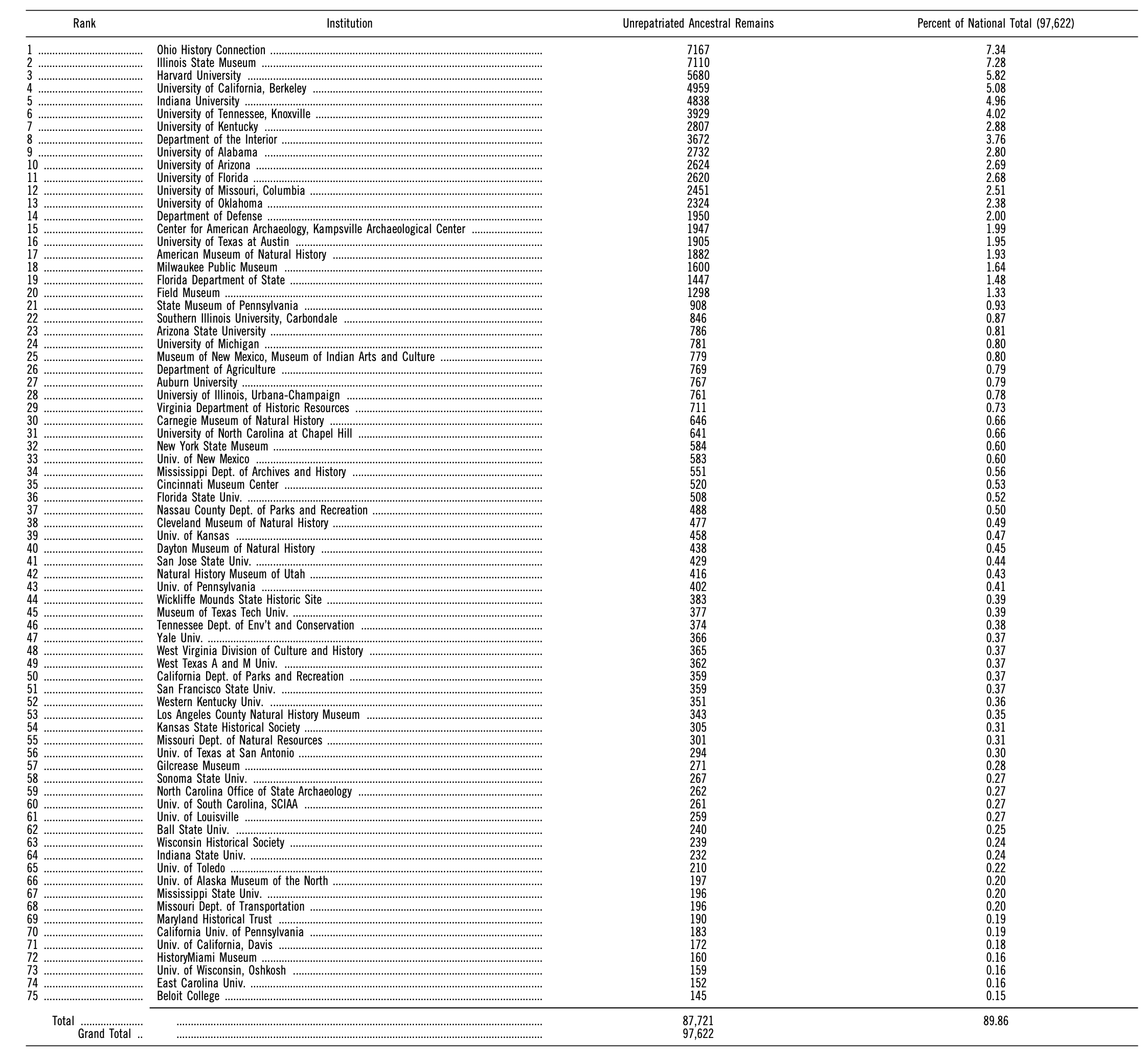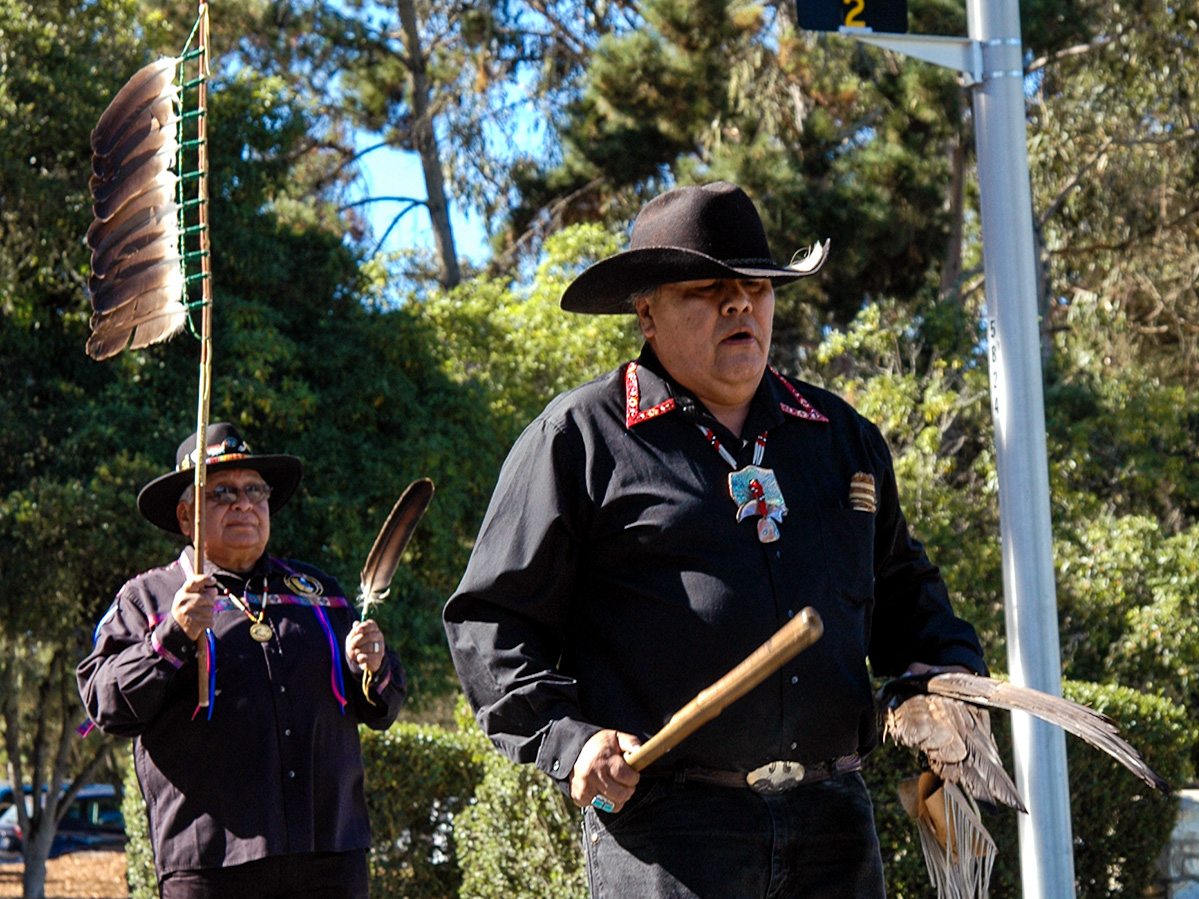Indianz.Com > News > NAGPRA enforcement enters new era after more than 30 years
NAGPRA enforcement enters new era after more than 30 years
Wednesday, February 7, 2024
Indianz.Com
Museums and educational institutions are facing new pressures to comply with the
Native American Graves Protection and Repatriation Act (NAGPRA) amid high-level attention to the decades-old law.
NAGPRA regulations finalized by the Biden administration on the eve of the White House Tribal Nations Summit in December have already forced some institutions to remove cultural items from public view. The Field Museum in Chicago, Illinois, was one of the first to take action as it considers how to secure “consent” from the Native communities affected.
“The announcement that the Field Museum will cover some of its displays to follow federal regulations is progress,” said Prairie Band Potawatomi Nation Chairman Joseph “Zeke” Rupnick, who noted that his tribe, how based in Kansas, has roots in Illinois.
“But, this is an opportunity for the Field Museum to expedite its process and fully commit to meaningful engagement with Tribal Nations,” Rupnick said of the January 9 announcement.
Another prominent institution, the American Museum of Natural History (AMNH) in New York, New York, just closed two exhibit halls as it too reviews how to comply with the updated NAGPRA rules. In addition to requiring free, prior and informed consent from Native communities, the regulations impose new consultation guidelines and deadlines on entities with ancestral remains and cultural items.
“While the actions we are taking this week may seem sudden, they reflect a growing urgency among all museums to change their relationships to, and representation of, Indigenous cultures,” AMNH President Sean Decatur said in a January 26 letter to his staff.
But the regulations, which went into effect on January 12, aren’t the only way NAGPRA is gaining renewed attention. A leading Democratic lawmaker is calling out museums, universities and other entities, arguing they haven’t done enough to comply with a federal law that has been on the books for nearly 34 years. “For centuries, Native people have had everything stolen from them,” Sen. Brian Schatz (D-Hawaii), the chairman of the Senate Committee on Indian Affairs, said in a fiery speech on the floor of the U.S. Senate on February 1. The Field Museum in its announcement was quick to point out that it does not have any Native ancestral remains on public display. But Schatz characterized the institution by name as one of the many notable offenders of NAGPRA. A list Schatz entered into the Congressional Record shows the The Field Museum with nearly 1,300 Native ancestors still in its collection, decades after the passage of NAGPRA in 1990. The tally for the AMNH is even higher, at slightly more than 1,880 remains yet to be returned to their rightful communities, according to the lawmaker. “This smells of the worst kind of colonialism with a thin veneer of progressive ideology and verbiage,” Schatz said during his remarks, which lasted about eight minutes. But Schatz singled out a state-sanctioned nonprofit, a state-run museum system and three prominent educational institutions as engaging in far more egregious conduct when it comes to abiding by NAGPRA and returning ancestral remains to American Indians, Alaska Natives and Native Hawaiians. “Together, these five institutions still hold at least 30,000 Native ancestral remains,” Schatz said of the Ohio History Connection (7,167 ancestors), the Illinois State Museum (7,110 ancestors), Harvard University in Massachusetts, (5,680 ancestors) the University of California, Berkeley, (4,959 ancestors) and Indiana University (4,838 ancestors). It is no secret that federal agencies, museums, universities, colleges and other institutions have been slow to comply with NAGPRA. Since 1990, fewer than half of the 208,698 ancestral remains known to be in these collections have undergone a complete review, the Government Accountability Office (GAO) reported last October. When it comes to the 2,619,951 sacred items being held in collections, the record is somewhat better. According to the GAO’s snapshot report, about 29 percent of funerary objects haven’t gone through the complete NAGPRA process. “The Native American Graves Protection and Repatriation Act is an essential tool for the safe return of sacred objects to the communities from which they were stolen,” Secretary of the Interior Deb Haaland, who is the first Native person to serve in a presidential cabinet, said in explaining why her department advanced the NAGPRA regulations. “Among the updates we are implementing are critical steps to strengthen the authority and role of Indigenous communities in the repatriation process,” said Haaland, who is a citizen of the Pueblo of Laguna in New Mexico. “Finalizing these changes is an important part of laying the groundwork for the healing of our people.” Historically, non-Native entities have scuttled attempts to strengthen enforcement of NAGPRA. A simple two-word amendment to the law, for example, faced intense opposition from academics and researchers who have long argued that they should be able to study ancestral remains that they don’t believe can be connected to a present-day Native peoples. Following years of inaction, Haaland’s department has managed to make significant inroads. The new NAGPRA rule eliminates what are known as “culturally unidentifiable human remains” — a problematic category that has allowed institutions to hold onto ancestors indefinitely by claiming they aren’t connected to an Indian nation or to a Native Hawaiian organization (NHO).The National Association of Tribal Historic Preservation Officers (@NATHPO_org ) is urging Indian Country to tune into remarks from Sen. Brian Schatz (D-Hawaii) about enforcement of the Native American Graves Protection Act and Repatriation Act (NAGPRA). pic.twitter.com/6XfrqsehC9
— indianz.com (@indianz) February 1, 2024


Unrepatriated Ancestral Remains - NAGPRA
A list of 75 institutions holding Native ancestral remains was entered into the Congressional Record on February 1, 2024, by Sen. Brian Schatz (D-Hawaii). The table here shows the institution name and the number of unrepatriated ancestors. Download the list in a comma-separated values (CSV) format: CSV| Institution | Unrepatriated Ancestral Remains |
|---|---|
| Ohio History Connection | 7167 |
| Illinois State Museum | 7110 |
| Harvard University | 5680 |
| University of California, Berkeley | 4959 |
| Indiana University | 4838 |
| University of Tennessee, Knoxville | 3929 |
| University of Kentucky | 2807 |
| Department of the Interior | 3672 |
| University of Alabama | 2732 |
| University of Arizona | 2624 |
| University of Florida | 2620 |
| University of Missouri, Columbia | 2451 |
| University of Oklahoma | 2324 |
| Department of Defense | 1950 |
| Center for American Archaeology, Kampsville Archaeological Center | 1947 |
| University of Texas at Austin | 1905 |
| American Museum of Natural History | 1882 |
| Milwaukee Public Museum | 1600 |
| Florida Department of State | 1447 |
| Field Museum | 1298 |
| State Museum of Pennsylvania | 908 |
| Southern Illinois University, Carbondale | 846 |
| Arizona State University | 786 |
| University of Michigan | 781 |
| Museum of New Mexico, Museum of Indian Arts and Culture | 779 |
| Department of Agriculture | 769 |
| Auburn University | 767 |
| Universiy of Illinois, Urbana-Champaign | 761 |
| Virginia Department of Historic Resources | 711 |
| Carnegie Museum of Natural History | 646 |
| University of North Carolina at Chapel Hill | 641 |
| New York State Museum | 584 |
| Univ. of New Mexico | 583 |
| Mississippi Dept. of Archives and History | 551 |
| Cincinnati Museum Center | 520 |
| Florida State Univ. | 508 |
| Nassau County Dept. of Parks and Recreation | 488 |
| Cleveland Museum of Natural History | 477 |
| Univ. of Kansas | 458 |
| Dayton Museum of Natural History | 438 |
| San Jose State Univ. | 429 |
| Natural History Museum of Utah | 416 |
| Univ. of Pennsylvania | 402 |
| Wickliffe Mounds State Historic Site | 383 |
| Museum of Texas Tech Univ. | 377 |
| Tennessee Dept. of Env't and Conservation | 374 |
| Yale Univ. | 366 |
| West Virginia Division of Culture and History | 365 |
| West Texas A and M Univ. | 362 |
| California Dept. of Parks and Recreation | 359 |
| San Francisco State Univ. | 359 |
| Western Kentucky Univ. | 351 |
| Los Angeles County Natural History Museum | 343 |
| Kansas State Historical Society | 305 |
| Missouri Dept. of Natural Resources | 301 |
| Univ. of Texas at San Antonio | 294 |
| Gilcrease Museum | 271 |
| Sonoma State Univ. | 267 |
| North Carolina Office of State Archaeology | 262 |
| Univ. of South Carolina, SCIAA | 261 |
| Univ. of Louisville | 259 |
| Ball State Univ. | 240 |
| Wisconsin Historical Society | 239 |
| Indiana State Univ. | 232 |
| Univ. of Toledo | 210 |
| Univ. of Alaska Museum of the North | 197 |
| Mississippi State Univ. | 196 |
| Missouri Dept. of Transportation | 196 |
| Maryland Historical Trust | 190 |
| California Univ. of Pennsylvania | 183 |
| Univ. of California, Davis | 172 |
| HistoryMiami Museum | 160 |
| Univ. of Wisconsin, Oshkosh | 159 |
| East Carolina Univ. | 152 |
| Beloit College | 145 |
Related Stories
Search
Filed Under
Tags
More Headlines
Native America Calling: Can the right approach close the Native immunization gap?
Cronkite News: Long COVID cases remain high in Arizona
Native America Calling: Eyes in the sky for development, public safety, and recreation
Native America Calling: Three new films offer diverse views of Native life
NAFOA: 5 Things You Need to Know this Week
Chuck Hoskin: Cherokee Nation works toward cure for arthritis
Native America Calling: Protecting young people from the down sides of social media
Cronkite News: Fake ‘shaman’ among candidates failing to make Congressional ballot
Native America Calling: New Native voices in poetry
Cronkite News: Tribes air concerns about border at hearing in nation’s capital
Native America Calling: Indiginerds descend on Oklahoma City
Native America Calling: Political leaders target tribes with unfounded claims
Cronkite News: First Native woman in space shares unique journey
Native America Calling: Tackling a troubling trend for Native women in prison
Chuck Hoskin: Cherokee Nation safeguards our Native language
More Headlines
Cronkite News: Long COVID cases remain high in Arizona
Native America Calling: Eyes in the sky for development, public safety, and recreation
Native America Calling: Three new films offer diverse views of Native life
NAFOA: 5 Things You Need to Know this Week
Chuck Hoskin: Cherokee Nation works toward cure for arthritis
Native America Calling: Protecting young people from the down sides of social media
Cronkite News: Fake ‘shaman’ among candidates failing to make Congressional ballot
Native America Calling: New Native voices in poetry
Cronkite News: Tribes air concerns about border at hearing in nation’s capital
Native America Calling: Indiginerds descend on Oklahoma City
Native America Calling: Political leaders target tribes with unfounded claims
Cronkite News: First Native woman in space shares unique journey
Native America Calling: Tackling a troubling trend for Native women in prison
Chuck Hoskin: Cherokee Nation safeguards our Native language
More Headlines
